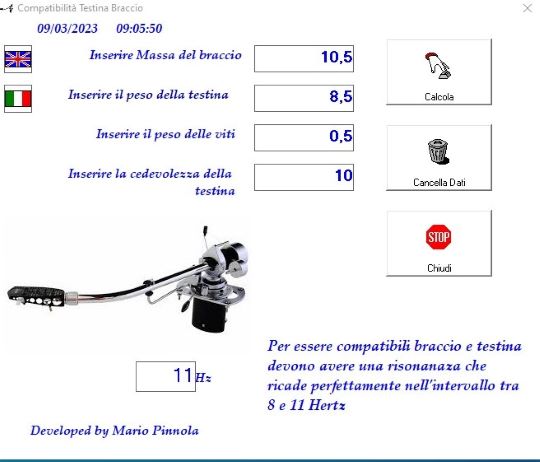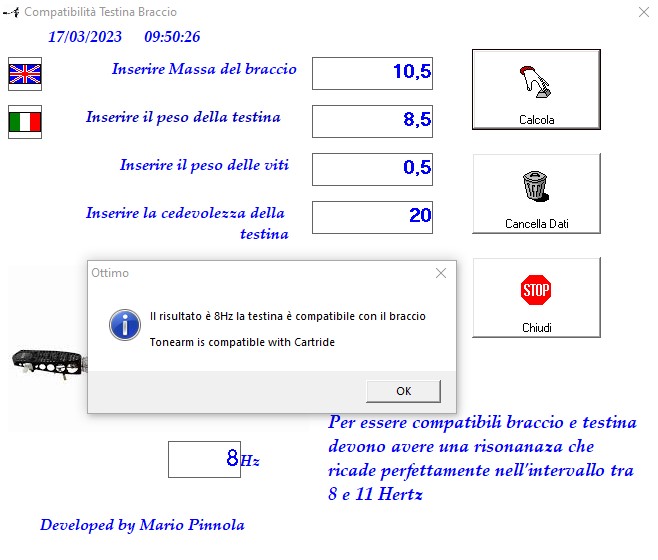Arm Cartridge Resonance Calculator
Easy to use freeware for a correct cartridge-arm matching

[ Home | Staff & Contacts | HiFi Playground | Listening tests | DIY & Tweakings | Music & Books ]

Product: Software for a correct cartridge-arm matching
Manufacturer: Mario Pinnola / freely distributed by TNT Audio - Italy
Recommended Retail Price: Free
Reviewer: Piero Canova - TNT Italy
Reviewed: March, 2023
The growing popularity of vinyl records is boosted by two categories of users: young customers that are attracted by a fascinating format and less young people that see, in the vinyl record, a return to their youth. In both cases, the basic information on how to properly chose or set-up a turntable is either unknown or well-forgotten. One of our readers, Mario Pinnola, has decided to develop a very easy calculator to determine if the cartridge you want to use has the right characteristics for your arm, so here I take the opportunity to outline details of the cartridge-arm resonance problem.
As consumers we are progressively getting used to a kind of "plug & play" syndrome. Most of the appliances in our homes are now interconnected, but to do this the only thing we need to do, in most cases, is to press one or two buttons, taking a couple of seconds. A turntable is probably the most distant device from this philosophy and perhaps this is the reason why I like them (the journey, not the arrival matters, Marcel Proust); to get the best form a turntable you can't be a passive listener, but rather chose the right components and then put them together to achieve the best results possible.
So, it isn't enough to choose from the endless catalog of components available today, the ones we believe are better in absolute terms and that are within our spending budget; we need also to take care that some physics fundamentals are respected and correctly matched. One of them well known to vinyl aficionados, but rather obscure to newcomers is the relation between the effective mass of the arm and the compliance of the cartridge. I have mentioned before that these are physics concepts that sometimes tend to be complicated so let me try to simplify them. What we call "effective mass" is more correctly defined as the moment of inertia of our arm. Any mass placed at a distance from a pivot will tend to stay at rest and to move it you need to apply a force; the same if it is moving and you want to accelerate or stop it. The higher the mass the more difficult will it be to change its status. On the other hand, mechanically, a cartridge is a rod(the stylus) connected to the cartridge body through a suspension which is normally a layer of an elastomeric material. We measure the elasticity of this rubber component using the compliance value; the peculiarity of compliance is that the lower the value the harder it is to compress and vice-versa. The two together resemble a weight connected to a spring: the heavier the weight and the softer the spring mean acompletely different way of reacting to forces. In particular, the kind of oscillations we are interested in is the resonance frequency. The resonance frequency is a specific frequency typical of an elastic system in which the amplitude of the movement continues to increase leading to massive movements and uncontrolled situations (see the video of what happened to the Tacoma Narrows bridge around 1930).
Fortunately, we don't have to deal with wind and bridges, but if or cartridge-arm system begins to resonate at the wrong frequencies the extreme consequences are either a severe mis-tracking or the mechanical amplification of this resonating frequency that will be added to the music signal. Normally resonating frequencies are in the very low range so they can damage our power amplifiers or the woofers of our speakers. It is generally accepted that the correct resonating frequency of a cartridge-arm system should be in the 8 to 11Hz region. The question is then how to collect the data and perform the calculation. Data on the arm effective mass are supplied by the manufacturers; the same is for the compliance of the cartridges, and we need some care to use when using these data. The majority of the cartridges sold today are produced in Europe, Japan or the US. If we use the European values of compliance as reference (measured at 10Hz), considering that in Japan they measure it at 100Hz you must multiply it by a value ranging between 1,5 and 2 to get a value equivalent to the European one. In literature both values are considered correct by some authors, so either you perform the calculation with both values or you can use as compromise a midpoint value of 1,75. In the US the compliance value is measured statically so to have a value equivalent to the European one you need to divide the US value in half. The unit commonly used to measure the compliance is cu (compliance unit).
The software that our reader has developed demands you to input four data points as in the picture below. As an example, I have made the calculation for a SME V tonearm with a Shelter 901 III cartridge. The arm has an effective mass that on some websites is indicated as 10g while others report 11g so I have dialed in 10,5g. The cartridge has a weight of 8,5g, the screws 0,5g and the compliance is 10cu, but measured according to Japanese standards so for our software we need to multiply it by 1,75.

The result ranges from 8 Hz using a factor 2 to 9 Hz with a factor 1,5 which is good, but a bit on the low side.To increase slightly the resonance frequency you need to use an arm with a lower mass. Using the same arm, but with a Denon DL 103 that has a mass of 8,5g and a compliance of 5 cu leads to a frequency between 11 and 13 Hz which is too high and not recommended; my DL 103S which has a body in Graphite and a weight of 12,5g gives a frequency between 10 and 11Hz and so-on. This last example gives a possible solution to some matching problems: in some arms like Schroeder the cartridge is fixed to a small metal plate that is then mounted on the arm via a screw. By changing the metal of the small plate (aluminum, brass) it is as if you were changing the mass of your cartridge allowing to have the right matching. As an alternative you can look for some heavier screws.
This very simple software allows immediate verification of wether the cartridge-arm matching is mechanically correct. In this way, you can exclude gross mistakes when buying an arm or a new cartridge. Thank you Mario again for having dedicated your time to simplify the procedures involved in a turntable setup. Click here to download the .zip file containing the software (Windows only). A basic English interface is included.
DISCLAIMER. TNT-Audio is a 100% independent magazine that neither accepts advertising from companies nor requires readers to register or pay for subscriptions. If you wish, you can support our independent reviews via a PayPal donation. After publication of reviews, the authors do not retain samples other than on long-term loan for further evaluation or comparison with later-received gear. Hence, all contents are written free of any “editorial” or “advertising” influence, and all reviews in this publication, positive or negative, reflect the independent opinions of their respective authors. TNT-Audio will publish all manufacturer responses, subject to the reviewer's right to reply in turn.
© Copyright 2023 Piero Canova - piero@tnt-audio.com - www.tnt-audio.com
[ Home | Staff & Contacts | HiFi Playground | Listening tests | DIY & Tweakings | Music & Books ]